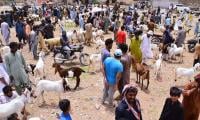ISLAMABAD: Farmers are compelled to purchase fertilisers beyond the rate estimated by the government on account of sharp reduction in tariffs on gas supplied to urea manufacturers, it emerged on Monday.
The important agriculture input is seen being sold as far as Rs1,880/bag, which is 13 percent more than the government’s fixed price and despite the government tall claims of cutting down the urea prices by Rs375/bag to Rs1,665/bag through waiving off of gas infrastructure development cess (GIDC) on gas supply to fertiliser sector.
In January this year, the government withdrew GIDC on gas to fertiliser manufacturers aimed at providing price relief to farmers for buying more nutrients to improve crops’ yields amid stunted growth in the agriculture sector, which decelerated to 0.8 percent in the last fiscal 2018/19, from 3.9 percent a year earlier.
The GIDC on feed stock to fertiliser sector was reduced to Rs5/million metric British thermal unit (mmBtu) from Rs300/mmBtu. Besides, GIDC on gas fuel stock was also cut to Rs5/mmBtu from earlier Rs150/mmBtu.
Now, fertiliser markers are charged Rs10/mmBtu for both feed and fuel stocks instead of GIDC of Rs440/mmBtu.
Minister for National Food Security and Research Khusro Bakhtyar, earlier this month, said the government estimated urea prices at Rs1,665/50-kilogram bag, down Rs375, as a result of GIDC cuts.
Instead of coming down, fertiliser prices increased a quarter of a percent, in a span of one week, and is still much higher than the government fixed prices.
Apparently either the fertiliser companies are not implementing the government’s orders of cutting the prices despite taking benefit of billions of rupees after abolition of GIDC or government’s own price monitoring system is too weak to control the traders selling the agriculture input at higher prices.
The Pakistan Bureau of Statistics (PBS) data showed that urea price averaged at Rs1,721/bag for the week ending on March 12 in 13 major localities and urban centres, compared with Rs1,717/bag in the previous week, indicating that farmers are paying Rs52 more than the government’s fixed price.
PBS data showed that urea price was Rs1,880/bag in Faisalabad, Rs1,740/bag in Lahore and
Bahawalpur, Rs1,730/bag in Rawalpindi, Rs1,720 in Gujranwala, Rs1,700 in Sargodha and Peshawar, Rs1,650 in Sukkur and Rs1,640/bag in Multan.
Sona urea average price was reduced 0.65 percent to Rs1,694/bag, compared to Rs1,705. It was down 5.59 percent over the corresponding week of last year when its price was recorded at Rs1,795/bag.
In the week under review, sona urea price was Rs1,750/bag in Peshawar and Bannu, Rs1,740 in Lahore, Rs1,730 in Rawalpindi and Sargodha, Rs1,720 in Gujranwala, Rs1,700 in Faisalabad, Rs1,657 in Bahawalpur, Rs1,655 in Multan, and Rs1,650/bag in Hyderabad, Sukkur, Larkana and Quetta.
SS phosphate (GR) average price increased 0.88 percent week-on-week to Rs1,057/bag and 4.46 percent year-on-year.
The highest price of Rs1,150/bag was recorded in Larkana and lowest of Rs950/bag in Bahawalpur and Hyderabad.
Average price of nitrogen, phosphorus, and potassium fertiliser remained unchanged at Rs2,977/bag. However, it was 15 percent more than the last year’s price of Rs2,588/bag.The highest price of Rs3,100/bag was in Lahore, while the lowest price of Rs2,700/bag was in Larkana.
Diammonium phosphate (DAP) price fell 0.33 percent week-on-week to Rs3,415/bag and 3.45 percent year-on-year.
In Quetta, DAP price of Rs3,800/bag was highest and lowest of Rs3,200/bag in Hyderabad. Nitro phosphate price declined 0.82 percent week-on-week to Rs2,545/bag, and 11.56 percent year-on-year. Sulphate potash price was down 0.16 percent week-on-week to Rs4,238/bag, while it was up 0.62 percent year-on-year. Calcium ammonium nitrate price inched down 1.82 percent week-on-week to Rs1,573 and decreased 2.01 percent year-on-year, according to the PBS data.
The headquarters of the Sui Southern Gas Company . — APP FileKARACHI: Sui Southern Gas Company has launched a fresh...
The logo of the ExpoMed Eurasia. — CA MI websiteKARACHI: Pakistan is participating in ExpoMed Eurasia, a leading...
Gold bars are seen in this undated file photo. — AFP/FileKARACHI: Gold prices increased by Rs500 per tola on...
FFBL Head Office building can be seen in Islamabad. — FFBL WebsiteKARACHI: Fauji Fertilizer Bin Qasim Limited has...
Representational file of an BMW car. — AFP FileLAHORE: Small improvements in economic credentials of the country are...
A fuel station worker filling petrol in vehicle at a fuel station in Karachi on Tuesday, April 16, 2024KARACHI: After...







